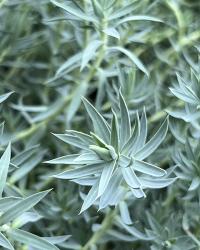Euphorbia
Milkwort
Named after Euphorbus, physician to the king of Mauritania, this robust, sun-loving genus includes the familiar Poinsettia and is over 1600 species strong. Most Euphorbia have a poisonous milky sap and soft-colored bracts that surround subtly defined flowers. Autumn watches many of their narrow green leaves turn shades of red, orange and yellow.
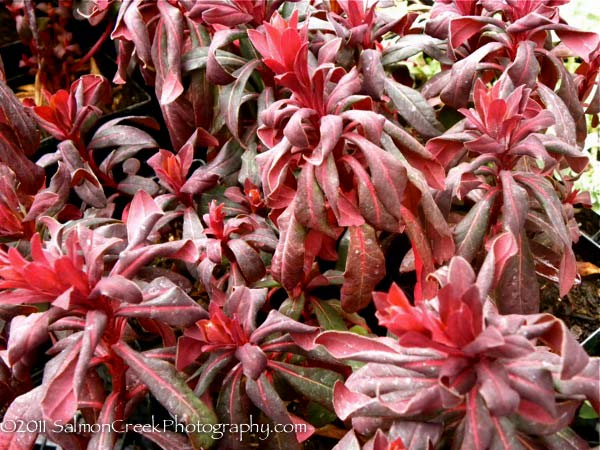
A gorgeous medley of deep burgundy, bronzy maroon and ruby red suffuses this Euphorbia's head turning foliage. Cresting a well-groomed base defined by plush evergreen leaves and sturdy stems, plentiful ebullient chartreuse blooms provide vivid contrast. Compact, hardy and downright irresistible ‘Ruby Glow’ can be nestled near the front of the border, along a pathway or showcased in a patio container. (uspp#22,200)
Blooms March–May.
Size: 12" – 18" high x 18" wide.
Hardy to zone 6.
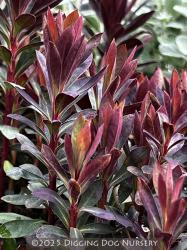
Chanced upon at Notcutts Nursery in England, this gold medal-winning ‘Redwing’ sport premiers plentiful lemon-lime colored flowers accompanied by a dramatic dose of red-imbued new growth and stems, plus elliptical dark burgundy and purple mature leaves. Tailored, well-branched and thickset, the bushy undemanding habit graces containers, mixed borders or rock gardens with velvet-like allure, while abiding deer and shallow rocky soil as well as periodic dry conditions. ‘Blackbird’ retains its evergreen good looks year round in warmer locales. (pp#17,178)
Blooms May–June
Size: 12" – 2' 0" high x 12" – 2' 0" wide.
Hardy to zone 6.
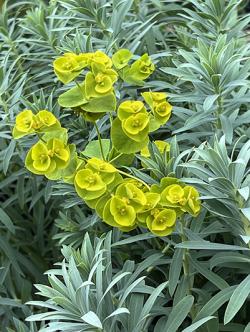
This choice Euphorbia hybrid between nicaeensis and seguieriana ssp. niciciana should make its way into more gardens. Crowned by yellow-green flower heads, attractive, blue-gray linear foliage is densely arranged, forming a compact and bushy evergreen mound. Cistus ‘Grayswood Pink’ and Thymus ‘Archer’s Gold’ bring contrasting accents to its pale pointed leaves and glowing blooms.
Blooms July–September
Size: 18" high x 2' 0" wide.
Hardy to zone 5.
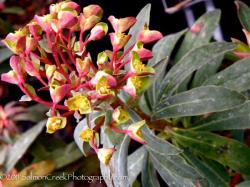
A standout for its wine-colored new growth, bronzy purple foliage with red-hued leaf undersides and stocky red stems, this robust, low growing wulfenii hybrid boasts large, cylindrical, golden yellow flower heads. Try planting in a mixed border with Cistus ‘Snow White’ and Cynoglossum nervosum for spectacular concurrent blooms.
Blooms April–late July.
Size: 2-1/2' high x 3' 0" wide.
Hardy to zone 7.
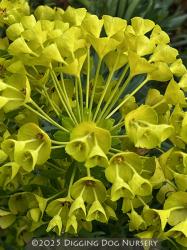
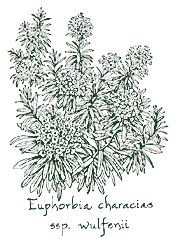
Distinctive and drought tolerant, this Euphorbia deserves to be used as a specimen. Its rounded flower heads are chartreuse, reaching 6 to 9 in. across and 9 in. high. Combine with Epilobium ‘Everett’s Choice’ plus bronzed Carex tenuiculmis, and enjoy the dramatic array of color and texture.
Blooms March–June
Size: 3' 0" – 5' 0" high x 3' 0" – 4' 0" wide.
Hardy to zone 7.
Topped with the same voluminous chartreuse flower heads as Euphorbia characias, this dapper lower-growing cultivar develops a more closely-knit bush-like habit. Stout upright stems are wrapped in slender gray-green leaves that keep the deer at bay and offer year-round allure. ‘Bruce’s Dwarf’ can festoon a stone wall or take a border’s front-row seat, where its grandiose day-glow blooms can be positioned near Geranium ‘Johnson’s Blue’ for a riveting spectacle.
Blooms March–early July
Size: 2' 0" – 3' 0" high x 2' 0" – 3' 0" wide.
Hardy to zone 7.

A selection made from wild seed collected in the former Yugoslavia by the namesake, this charismatic Euphorbia is esteemed for its handsome compact profile and glowing yellow-green conical inflorescences. Large rounded and broad heads taper towards the base while housing crowded bell-shaped flowers.
With color that promises to exhilarate, ‘John Tomlinson’ unites swirls of waxy blue-gray leaves on green stems beneath dazzling, sunshine-bright blooms alongside warm-hued Isoplexis canariensis in our mixed border.
Blooms March–June.
Size: 3' 0" – 4' 0" high x 3' 0" – 4' 0" wide.
Hardy to zone 7.
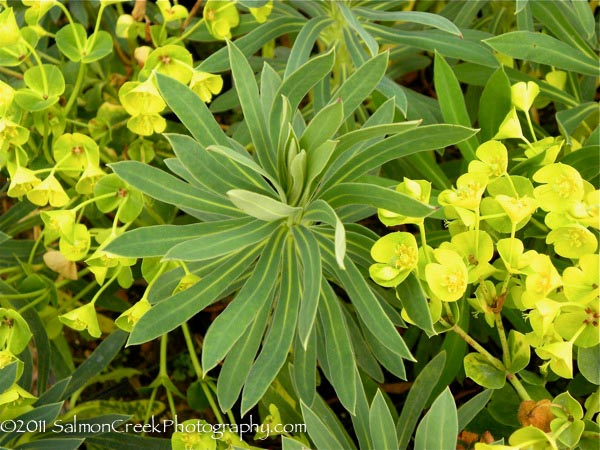
This show-stopping spurge was bred into being by the late plantswoman Margery Fish. Large, glowingly yellow blooms have a bright canary chroma that competes with the sun. Broad and bushy, its compact forest of erect stems is lined with slender gray-green leaves, relaxing downward in graceful arcs.
Blooms March–early July
Size: 3-1/2' high x 3-1/2' – 4' 0" wide.
Hardy to zone 7.
Euphorbia characias ‘Red Wing’ (P-1106)
Each $11.75
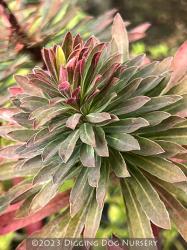
Perhaps more muted in color than a cardinal’s wing but still as captivating, this new cultivar is enlivened with red-tinged young growth and red floral buds held by reddish stems. All this rubescent coloring richly complements the handsome dark green foliage, and in late winter the profusion of electric yellow-green bracts set its compact form aglow. Appealing year round, ‘Red Wing’ can be paired with Helianthemum.
Blooms late March–May
Size: 20" – 2' 0" high x 2' 0" wide.
Hardy to zone 5.

Honoring plantsman Kent Copton, who developed both a garden and a nursery in Faversham, England, this well-groomed shrubby Euphorbia produces finely hewn cool bluish green foliage and billowing masses of lime-green flowers in an endless summer procession. Compared to E. ‘Dean’s Hybrid’ or E. ‘Blue Haze’, its needle-like linear leaves are longer, while its larger semievergreen mound surpasses E. ‘Limewall’s. For a lovely floral pairing, ‘Copton Ash’ can be planted with Geranium sanguineum var. lancastriense along a pathway, amidst rock work or in a planter.
Blooms May–October
Size: 2' 0" high x 2' 0" wide.
Hardy to zone 7.
Euphorbia ‘Dean’s Hybrid’ (P-1337)
Each $11.75
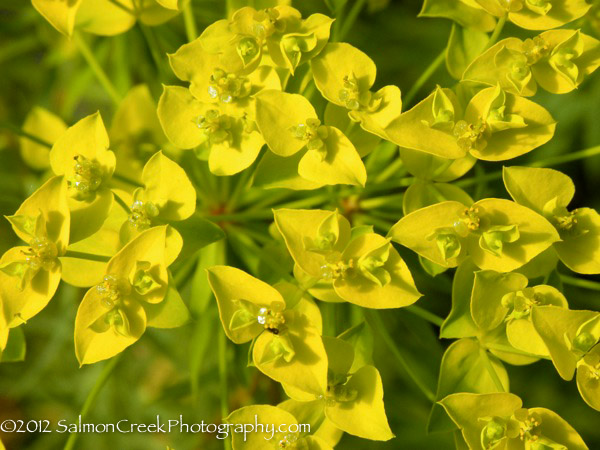
We have Dean Dalton of Occidental, California to thank for discovering this brilliantly colored, marathon blooming Euphorbia. Electrifying billows painted in acid yellows envelope a dense green globelike mound of fine textured narrow foliage.
First staged in spring, followed by a rebloom from summer until nearly winter, the fantastic floral show eventually attains orange hues, further heightening its low growing understory. In addition to his untiring floriferous nature, ‘Dean’s Hybrid’ maintains a well mannered, carefree profile that looks downright extraordinary as a container subject, spotlighted atop a wall or by a staircase.
Blooms April & September–October.
Size: 18" – 2' 0" high x 2' 0" wide.
Hardy to zone 7.
Dwelling above 5000 ft. throughout the eastern Himalayas in forest clearings and grazed hillsides, this superb robust species sports olive-green foliage with a springtime rubescent blush and distinctive milky white midribs. Staunch, red-imbued clumping stems bolster summer blooming lime-yellow inflorescences. We spotted this unique form of Euphorbia donii at Christopher Lloyd’s Great Dixter years ago and have since enjoyed its cool-colored bracts swaying amid Sanguisorba ‘Red Thunder’ in our own garden.
Blooms June – October.
Size: 5' 0" high x 4' 0" wide.
Hardy to zone 5.
Euphorbia ‘Excalibur’ (P-0743)
Each $11.75
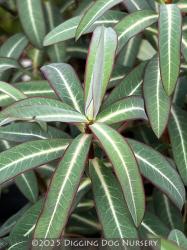
Rallying exceptional three season appeal, this regal British Euphorbia is most likely a hybrid between Euphorbia cornigera and Euphorbia schillingii. Sumptuous red-tinted young shoots enhance the mature green leaves that don prominent creamy midribs plus fine-drawn plush burgundy margins. Crowned by long-lasting flowers with greenish yellow bracts, ‘Excalibur’s erect habit flushes crimson for a snazzy fall finale and remains evergreen in milder climates.
Blooms June–August
Size: 3' 0" high x 15" – 2' 0" wide.
Hardy to zone 5.
Warm colors radiate from this vigorous seedling selection by Clive Jones, named in honor of the house he was living in at the time. Bronzy pink tips, colorful reddish stems and leaf margins, burnt orange flower bracts and magnificent fall color give ‘Fern Cottage’ a cheerful rosy glow through most of the season.
Blooms March–July.
Size: 3' 0" – 3-1/2' high x 2' 0" & spreading wide.
Hardy to zone 6.
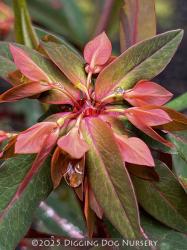
This bold native of the Himalayas and western Asia warms any rock garden and makes a magnificent companion to Corydalis f. ‘Blue Panda’ and Kerria ‘Albiflora’. ‘Fireglow’s flame orange bracts and brick-colored flowers stand torchlike on strong pomegranate red stems, and its soft green foliage blushes crimson and yellow in the fall.
Blooms April?July.
Size: 3' 0" high x 2' 0" & spreading wide.
Hardy to zone 6.
Euphorbia griffithii ‘Great Dixter’ (P-1232)
Each $12.50
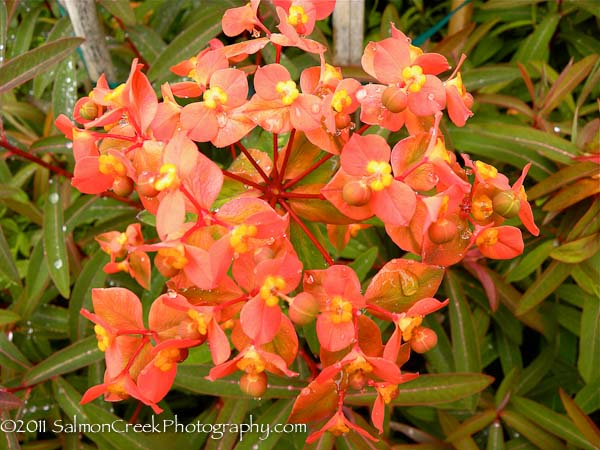
The late renowned garden writer Christopher Lloyd, selected this superb Euphorbia for its sumptuous display of fiery hues. Debuting purple-tinged coral shoots, reddish bronze stems, dark green foliage flushed with copper-red tints and burnt apricot-pink blooms, ‘Great Dixter’ seldom experiences a lackluster moment. The unforgettable radiance that emanates from this compact griffithii can be shown to great effect next to Kniphofia ‘Bee’s Sunset’.
Blooms April–July
Size: 2' 0" – 3' 0" high x 2' 0" & spreading wide.
Hardy to zone 6.
Euphorbia ‘Helen Robinson’ (P-0849)
OUT OF PRODUCTION AT THIS TIME
Email me when this plant is available
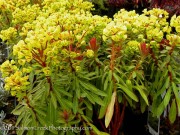
From the robbiae side of the family, this choice, stalwart Euphorbia inherits its compact stature, shade tolerance, and handsome, stout rosettes of blunt-tipped, dark green leaves; the characias side contributes the good-sized chartreuse flower heads. In our garden, it acccompanies Anchusa with a carpet of Corydalis ‘Pere David’ skirting beneath.
Blooms April–mid-July.
Size: 2-1/2' high x 3' 0" wide.
Hardy to zone 7.
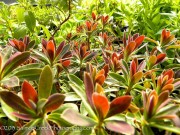
Evoking images of viridescent dragon scales, pointed blue-green leaves create a compact deer-proof assemblage that’s infused with reddish purple tinges. This tidy-looking robust Milkwort shoulders summer-blooming chartreuse flower heads nearly one foot across. Consorts such as Panicum ‘Shenandoah’ and Eupatorium ‘Gateway’ accentuate its colorful hues.
Blooms July–October
Size: 2' 0" – 2-1/2' high x 3' 0" wide.
Zone 6/7.
Each $11.75

Small, whorled linear leaves, bathed in tranquil bluish celadon hues, are pointed and narrow, yet slightly broader and not as closely arranged as those of ‘Dean’s Hybrid’. A long lasting day glow display of bright lime-green flower heads and wine-infused older stems bring dramatic elements to the low tailored evergreen mound that needs minimal water and braves the deer. Grateful for a well-drained niche, ‘Limewall’s effulgent blooms enliven perennials such as Saponaria ‘Max Frei’ and Origanum libanoticum.
Blooms May–October.
Size: 12" high x 2' 0" wide.
Hardy to zone 7.
Native to the mountain meadows and forest clearings of the Himalayas, this vigorous species is most notable for its upright stature and beautiful foliage, highlighted with white midveins and pinkish margins. Along with its big and bright chartreuse flowers, these colors make for a lovely combination with Nepeta ‘Pool Bank’, Miscanthus ‘Malepartus’ and Aster ‘Mönch’ in the perennial border.
Blooms mid-May – September.
Size: 4' 0" – 5' 0" high x 3' 0" – 4' 0" wide.
Hardy to zone 6.
Each $11.75
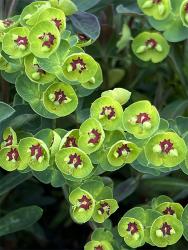
A well-loved garden mainstay since the late 1800s, this naturally occurring evergreen hybrid between Euphorbia amygdaloides and Euphorbia characias was discovered in France. Stiff upright stems plus narrow lance-shaped ash-green leaves define the dapper compact mound that bolsters voluminous dense terminal cymes with burgundy-centered lime-yellow bracts. Equally at ease in traditional borders or more modern venues, Euphorbia x martini′s hardy subshrub-like habit toughs coastal sites, dry conditions, lean soil and deer, while its zingy long-lasting flowers, purple-tinged new growth and red-stained winter-time stalks afford vivacious multiseason allure.
Blooms March–June
Size: 2' 0" high x 2' 0" wide.
Hardy to zone 6.
Each $12.00

We first saw this evergreen Euphorbia at Sissinghurst; its native home is the Canary Islands. Shrub-like and taller than its relatives, its smooth green stems are clothed with narrow, whorled apple-green leaves marked by prominent cream-hued midribs. The "honey-bearing" epithet foretells the ambrosial aroma of the intriguing flowers, which range in color from butter to terracotta. Stately in a container, is not reliably hardy where winters are cold and wet.
Blooms June–October
Size: 5' 0" – 7' 10" high x 3-2/3' – 5' 0" wide.
Zone 5/6.
Each $11.75
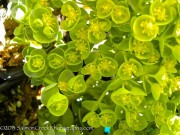
Waxed silvery-blue evergreen leaves held in succulent spirals make this stalwart perennial appear otherworldly. In midwinter, its thick trailing stems grow upward, fashioning an 8 in. tall base for the starry, lime-green flowers and lemon-yellow bracts, which form large brilliant clusters, highlighted with pinkish streaks. A Eurasian native undaunted by cold, heat or drought, Euphorbia myrsinites brings an exotic touch to a well-drained site in the rockery or atop a dry stone wall.
Blooms April–June
Size: 15" high x 2' 0" wide.
Zone 5/6.
Euphorbia polychroma ‘Candy’ (P-0748)
Each $11.75

The sweet melding of purplish new spring tips amid narrow blue-tinged green leaves with ripple-edged margins plus flashy sulphur-yellow bracts distinguishes ‘Candy’s neat low-growing mound. A delectable addition to borders, rock walls and pathways, this carefree long-lived Euphorbia flaunts enticing rosy-red fall color, relishes dry well-drained nooks and tolerates poor soil.
Blooms February–May
Size: 12" – 15" high x 2-1/2' wide.
Zone 4b/5.
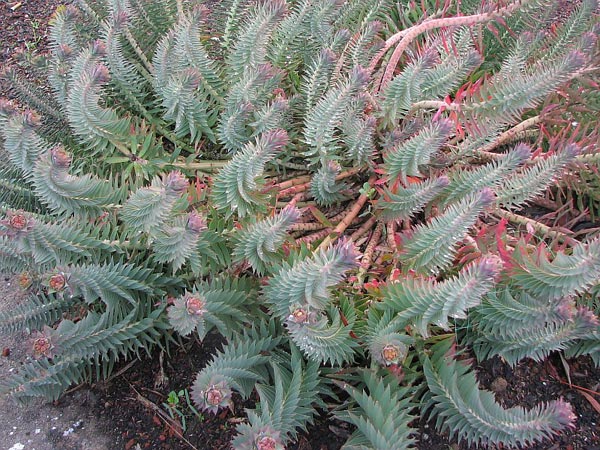
Beware! The sculptural patterns created by these sharply pointed, powder blue, narrow leaves clasping pale green stems may leave you feeling mesmerized. Warmed with burgundy tinges as the weather cools, the fleshy, evergreen foliage bolsters acid green, rounded flower heads that remind us of miniature poinsettia blooms.
Claiming the Mediterranean from Portugal to South Africa as its homeland, this easy-to-grow toughie asks only for a dry, sunny spot, and in turn promises superb winter color in a container or in the garden amid small bulbs and Agave ‘Garland’s Gold’.
Blooms April–June.
Size: 18" – 2' 0" high x 2' 0" wide.
Zone 7/8.
Euphorbia sikkimensis (P-0401)
OUT OF PRODUCTION AT THIS TIME
Email me when this plant is available
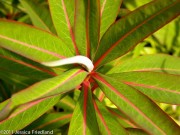
An Eastern Himalayan inhabitant, this summer blooming Euphorbia has young reddish shoots and a lovely pink cast to its new leaves. Mature foliage is large and apple green with a creamy pink midrib, while thick, upright reddish stems slowly spread, supporting the lime-green flowers without staking.
The Sikkim Spurge provides architectural interest and alluring foliar contrast when it flanks broad-leafed Salvia prezwalskii.
Blooms July – September.
Size: 4' 0" high x 2' 0" wide.
Hardy to zone 6.







